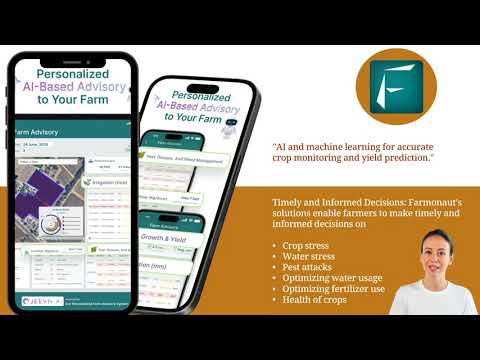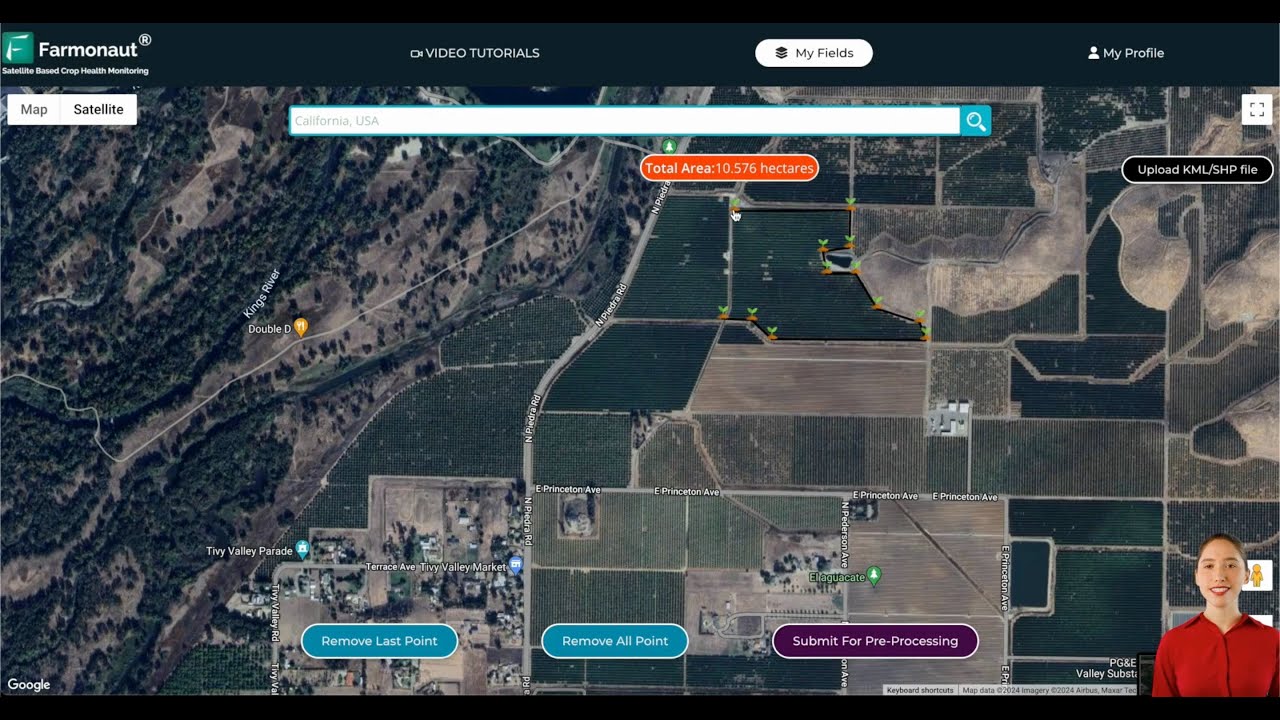2024 Farmland Rental Rates Forecast: Navigating Manitoba’s Agricultural Land Market Trends

“In 2024, flexible farm lease agreements are expected to increase by 30% due to market volatility.”
As we approach 2024, the agricultural landscape in Manitoba is experiencing significant shifts, particularly in the realm of farmland rental rates and agricultural land leasing. At Farmonaut, we understand the importance of staying ahead of these trends to help farmers and landowners make informed decisions. In this comprehensive analysis, we’ll explore the intricate dynamics of the farm rental market trends, shedding light on the factors influencing farmland value analysis and their impact on rental rates across different regions of Manitoba.
The Current State of Manitoba’s Farmland Rental Market
The farmland rental market in Manitoba has been a topic of intense discussion among farmers, landlords, and agricultural economists. As we look towards 2024, several key factors are shaping the landscape:
- Rising Production Costs: Crop production costs have been on an upward trajectory, influencing the delicate balance of farm profitability.
- Fluctuating Commodity Prices: Agricultural commodity prices continue to show volatility, affecting farmers’ ability to predict income and negotiate rental rates.
- Changing Weather Patterns: Manitoba’s weather has been increasingly unpredictable, impacting crop yields and, consequently, the value of farmland.
- Technological Advancements: The integration of precision agriculture technologies is changing the way farms are managed, potentially affecting land values.
These factors collectively contribute to a complex environment where both farmers and landlords are seeking to adapt their strategies for farmland rentals.
Forecasting 2024 Farmland Rental Rates
As we analyze the trends and data available, our forecast for 2024 farmland rental rates in Manitoba suggests a period of cautious adjustment. Here’s what we’re anticipating:
- Moderate Increases: We expect to see modest increases in rental rates, averaging between 2-5% across the province, with variations depending on specific regions and land quality.
- Regional Variations: Prime agricultural areas like the Red River Valley may see higher increases, while more marginal lands might experience stable or even slightly decreased rates.
- Flexible Agreements: There’s likely to be a surge in flexible farm lease agreements, allowing both parties to share risks and rewards more equitably.
To provide a clearer picture, let’s look at a comparative table of estimated farmland rental rates across different regions of Manitoba for 2024:
| Region | Cropland ($/acre) | Pasture ($/acre) | % Change from 2023 | Influencing Factors |
|---|---|---|---|---|
| Central Plains | 75-100 | 25-40 | +3% | High soil quality, proximity to markets |
| Interlake | 50-75 | 20-35 | +2% | Variable soil quality, livestock presence |
| Westman | 60-85 | 25-45 | +4% | Good crop diversity, stable yields |
| Parkland | 55-80 | 20-40 | +2.5% | Mixed farming operations, moderate soil quality |
| Eastern | 70-95 | 25-40 | +3.5% | Proximity to Winnipeg, diverse crop options |
This table provides a snapshot of the expected rental rates, showcasing the regional differences and the factors influencing these rates. It’s important to note that these are estimates and actual rates may vary based on specific local conditions and individual agreements.
Factors Influencing Farmland Value Analysis
Understanding the factors that contribute to farmland value is crucial for both farmers and landlords. Here are some key elements we’ve identified:
- Soil Quality: Prime agricultural land with high fertility continues to command premium rates.
- Location: Proximity to markets, processing facilities, and transportation hubs impacts value.
- Water Access: Reliable water sources for irrigation can significantly increase land value.
- Historical Yields: Consistent high yields make land more attractive and valuable.
- Infrastructure: Well-developed on-farm infrastructure like storage facilities can boost rental rates.
At Farmonaut, we leverage advanced satellite technology to provide detailed insights into land quality and potential productivity. Our platform offers valuable data on vegetation health (NDVI) and soil moisture levels, which can be crucial in determining fair rental rates.
The Impact of Production Costs on Rental Rates
One of the most significant factors influencing farmland rental rates is the ongoing increase in crop production costs. Let’s break down how these costs are affecting the market:
- Input Costs: Rising prices for seeds, fertilizers, and pesticides are squeezing profit margins.
- Machinery Expenses: The cost of purchasing and maintaining farm equipment continues to climb.
- Labor Costs: Skilled agricultural labor is becoming more expensive and sometimes scarce.
- Energy Prices: Fluctuations in fuel prices impact overall operational costs.
These increasing costs are putting pressure on farmers to negotiate more favorable rental terms to maintain profitability. Landlords, in turn, are faced with balancing fair returns on their land investments with the economic realities faced by their tenants.
The Role of Agricultural Commodity Prices
Agricultural commodity prices play a pivotal role in shaping farmland rental rates. As we look towards 2024, here’s how commodity markets are influencing the rental landscape:
- Price Volatility: Fluctuations in global markets for crops like wheat, canola, and soybeans create uncertainty in rental negotiations.
- Supply and Demand Dynamics: Changes in global food demand and supply chain disruptions impact local crop values.
- Trade Policies: International trade agreements and tariffs can significantly affect commodity prices and, consequently, land values.
- Alternative Crops: The introduction of new, high-value crops can drive up rental rates in certain areas.
Farmers and landlords are increasingly looking at multi-year averages and futures markets to establish more stable, long-term farm rental contracts. This approach helps mitigate the risks associated with year-to-year price fluctuations.
“Manitoba farmland rental rates have fluctuated up to 15% annually over the past 5 years.”
Adapting to Market Challenges: Flexible Farm Lease Agreements
In response to the dynamic agricultural environment, we’re seeing a significant trend towards flexible farm lease agreements. These innovative arrangements offer benefits to both farmers and landlords:
- Crop Share Leases: Landlords and tenants share both the risks and rewards of crop production.
- Flex Rent Agreements: Base rent plus a bonus based on yield or price performance.
- Stepped Rent: Gradual increases in rent over a multi-year lease period.
- Revenue Sharing: Rent calculated as a percentage of gross revenue from the farm.
These flexible arrangements allow for a more equitable distribution of risk and reward, fostering longer-term, stable relationships between landowners and farmers.
Explore Farmonaut’s API for detailed agricultural insights
Long-Term Farm Rental Contracts: Stability in Uncertainty
As the agricultural sector faces increasing volatility, there’s a growing interest in long-term farm rental contracts. These agreements offer several advantages:
- Predictability: Farmers can plan for the future with more certainty about their land access and costs.
- Investment Incentive: Longer leases encourage farmers to invest in soil health and infrastructure improvements.
- Relationship Building: Extended contracts foster stronger landlord-tenant relationships.
- Risk Management: Both parties can better navigate market fluctuations with a long-term perspective.
However, it’s crucial to build flexibility into these long-term agreements to account for significant changes in market conditions or farm profitability.
Agricultural Land Investment Strategies
For those considering agricultural land as an investment, the current market trends offer both opportunities and challenges. Here are some strategies to consider:
- Diversification: Investing in different types of agricultural land across various regions can spread risk.
- Value-Add Improvements: Enhancing land through irrigation systems or soil amendments can increase its value and rental potential.
- Sustainable Practices: Implementing conservation methods can improve long-term land value and attract environmentally conscious tenants.
- Partnering with Progressive Farmers: Seeking tenants who use advanced farming techniques can lead to better land stewardship and potentially higher returns.
At Farmonaut, we provide tools that can assist in making informed investment decisions. Our satellite-based crop health monitoring and AI-driven advisory systems offer valuable insights into land productivity and potential.
The Importance of Transparent Data in Decision Making
In the complex world of farmland rentals, access to accurate and timely data is crucial. Transparent information benefits all parties involved:
- For Farmers: Helps in negotiating fair rates and making informed decisions about land use.
- For Landlords: Provides insights into market trends and helps in setting competitive rates.
- For Policymakers: Assists in developing appropriate agricultural policies and support programs.
- For Investors: Enables better assessment of potential returns and risks in agricultural land investments.
Farmonaut’s platform contributes to this transparency by providing real-time data on crop health, weather patterns, and historical yield information. This data-driven approach helps create a more efficient and fair farmland rental market.
Check out our API Developer Docs for integration possibilities
Regional Spotlight: Manitoba’s Diverse Agricultural Landscape
Manitoba’s agricultural sector is characterized by its diversity, with different regions offering unique opportunities and challenges for farmland rentals:
- Red River Valley: Known for its rich soil, this region often commands premium rental rates for crops like canola and soybeans.
- Interlake Region: With a mix of crop and pasture land, this area sees varied rental rates depending on land use.
- Westman: Diverse crop production and generally stable yields make this region attractive for both cash crop and mixed farming operations.
- Parkland: Known for its livestock operations, this region often sees competitive rates for pasture land.
Understanding these regional differences is crucial for both farmers and landlords in negotiating fair and sustainable rental agreements.
The Future of Farmland Rentals: Innovation and Adaptation
As we look towards the future of farmland rentals in Manitoba, several trends are likely to shape the market:
- Technology Integration: The use of precision agriculture tools will increasingly influence land valuation and rental rates.
- Sustainability Focus: Growing emphasis on sustainable farming practices may impact rental agreements and land values.
- Climate Adaptation: Rental contracts may need to account for changing climate patterns and their impact on crop production.
- Data-Driven Decision Making: Increased use of data analytics in determining fair market rates and optimal land use.
Farmonaut is at the forefront of these trends, offering cutting-edge satellite monitoring and AI-driven insights to help farmers and landowners navigate this evolving landscape.
Navigating Challenges: Tips for Farmers and Landlords
For both farmers and landlords, navigating the current farmland rental market requires careful consideration and strategy. Here are some tips to help:
- For Farmers:
- Stay informed about local market trends and commodity prices.
- Consider flexible lease options to share risk with landlords.
- Invest in technologies that can demonstrate improved land management.
- Maintain open communication with landlords about farm operations and challenges.
- For Landlords:
- Understand the true value of your land, including its productive capacity and location advantages.
- Consider the long-term benefits of stable, reliable tenants over maximizing short-term gains.
- Be open to flexible rental arrangements that align with market conditions.
- Invest in land improvements that can justify higher rental rates.
By adopting these strategies, both parties can work towards mutually beneficial arrangements that support the long-term sustainability of Manitoba’s agricultural sector.
Conclusion: Embracing Change in Manitoba’s Farmland Rental Market
As we look towards 2024, the farmland rental market in Manitoba is poised for continued evolution. The interplay of factors such as production costs, commodity prices, technological advancements, and changing weather patterns will shape the landscape of agricultural land leasing. Both farmers and landlords must remain adaptable, informed, and open to innovative approaches in rental agreements.
At Farmonaut, we’re committed to providing the tools and insights needed to navigate these changes successfully. Our advanced satellite monitoring, AI-driven advisory systems, and data analytics platforms are designed to support informed decision-making in this dynamic environment.
By embracing transparency, flexibility, and data-driven strategies, stakeholders in Manitoba’s agricultural sector can work together to ensure a resilient and prosperous future for farmland rentals. As we move forward, the key to success will lie in fostering strong partnerships between farmers and landlords, leveraging technology, and adapting to the ever-changing agricultural landscape.

FAQ Section
Q: How are farmland rental rates typically determined in Manitoba?
A: Farmland rental rates in Manitoba are typically determined by factors such as soil quality, historical yields, location, current commodity prices, and local market conditions. Rates can vary significantly across different regions of the province.
Q: What is a flexible farm lease agreement?
A: A flexible farm lease agreement is a rental arrangement that allows for adjustments based on changing conditions such as crop yields or market prices. This type of agreement helps share risk between the landlord and tenant.
Q: How might climate change impact farmland rental rates in Manitoba?
A: Climate change could impact rental rates by affecting crop yields, changing the types of crops that can be grown, and altering water availability. Areas less affected by adverse weather conditions might see increased demand and higher rental rates.
Q: What role does technology play in modern farmland rental markets?
A: Technology plays a significant role in providing data for land valuation, monitoring crop health, and improving farm management practices. Tools like satellite imaging and precision agriculture can influence land value and rental rates.
Q: How long are typical farmland rental agreements in Manitoba?
A: While agreements can vary, many farmland rental contracts in Manitoba are annual or multi-year agreements. There’s a growing trend towards longer-term leases of 3-5 years or more to provide stability for both parties.



















